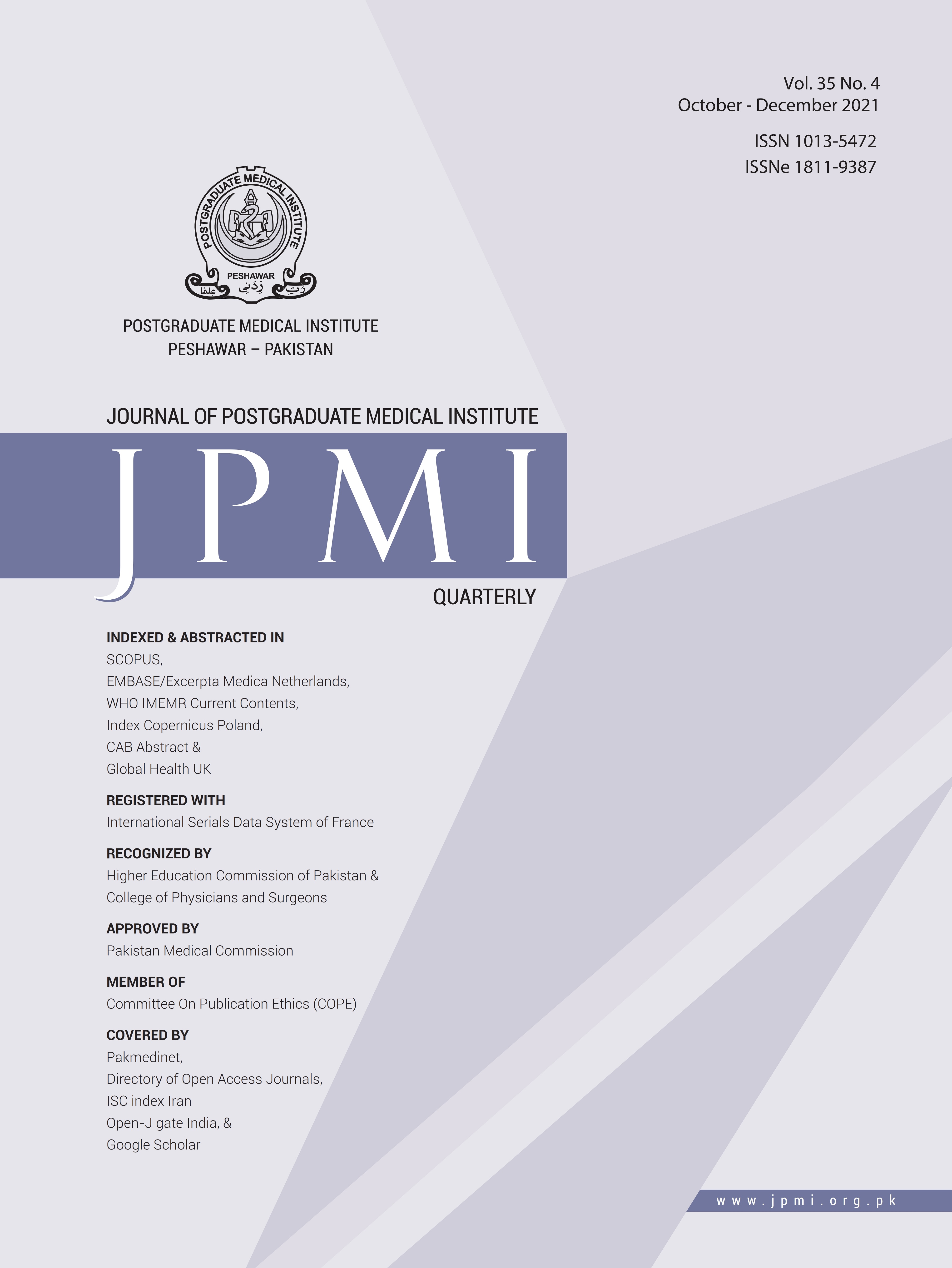THE OUTCOME OF PALLIATIVE STENTING IN CYANOTIC CONGENITAL HEART DISEASES
Main Article Content
Abstract
Objective: To determine the outcome of palliative stenting in children with cyanotic congenital heart diseases.
Methodology: From February 2018 to October 2020, the Department of Paediatric Cardiology at Lady Reading Hospital in Peshawar conducted a cross-sectional study on patients who underwent right ventricular outflow tract blocked Blalock Taussig shunt stenting or patent ductus arteriosus stenting for cyanotic congenital heart disease. The patients' information was gathered using a pre-formatted proforma. Pre- and post-procedure oxygen saturations were recorded for 48 hours. The favorable outcome was defined as an increase in oxygen saturation of at least 15%.
Results: The mean age of the sample (n=49) was 20±29 months. The etiology was Pulmonary Atresia (PA) with Patent ductus arteriosus (PDA) in 23 patients, followed by blocked Blalock Taussig Shunt (BT-Shunt) in 9 patients. The number of patients who underwent PDA stenting was 32, 9 patients had stenting of blocked BT-Shunt and 8 patients had RVOT stenting. The mean pre-intervention oxygen saturation was 43% ±8.9% and the mean post-intervention oxygen saturation was 81% ±5.3%. The number of patients who died was 2, one patient for RVOT stenting died on the table due to cyanotic spell while other post-PDA stenting died because of stent thrombosis.
Conclusion: RVOT, Patent Ductus arteriosus, and blocked Blalock Taussig shunt stenting was found effective in increasing oxygen saturation in children with cyanotic PDA.
Article Details
Work published in JPMI is licensed under a
Creative Commons Attribution-NonCommercial 2.0 Generic License.
Authors are permitted and encouraged to post their work online (e.g., in institutional repositories or on their website) prior to and during the submission process, as it can lead to productive exchanges, as well as earlier and greater citation of published work.
References
O’Connor MJ, Ravishankar C, Ballweg JA, Gillespie MJ, Gaynor JW, Tabbutt S, et al. Early systemic-to-pulmonary ar¬tery shunt intervention in neonates with congenital heart disease. J Thorac Car¬diovasc Surg. 2011;142(1):106–12. DOI: 10.1016/j.jtcvs.2010.10.033
Cinteza EE, Nicolescu AM, Filip C, Nicolae G, Duica G, Grigore CA, et al. Interventional treatment of Cardiac emergencies in children with congeni¬tal heart diseases. J Cardiovasc Emerg. 2019;5(1):7–17. DOI: 10.2478/jce- 2019-0002
Starr JP. Tetralogy of Fallot: Yes¬terday and today. World J Surg. 2010;34(4):658–68. DOI: 10.1007/ s00268-009-0296-8
Hirsch JC, Mosca RS, Bove EL. Com¬plete repair of Tetralogy of Fallot in the neonate: Results in the modern era. Ann Surg. 2000;232(4):508–14. DOI: 10.1097/00000658-200010000- 00006
Sen S, Dalvi B. Palliative balloon pul¬monary valvotomy in Tetralogy of Fal¬lot: Is there a role in 2021 Hearts. 2021;2(2):224–33. DOI: 10.3390/ hearts2020018
Alwi M, Choo K-K, Radzi NAM, Sami¬on H, Pau K-K, Hew C-C. Concomitant stenting of the patent ductus arterio¬sus and radiofrequency valvotomy in pulmonary atresia with intact ventric¬ular septum and intermediate right ventricle: Early in-hospital and medi¬um-term outcomes. J Thorac Cardio¬vasc Surg. 2011;141(6):1355–61. DOI: 10.1016/j.jtcvs.2010.08.085
Dorobantu DM, Pandey R, Sharabiani MT, Mahani AS, Angelini GD, Martin RP, et al. Indications and results of system¬ic to pulmonary shunts: results from a national database. Eur J Cardiothorac Surg. 2016;49:1553–1563 10.1093. DOI: 10.1093/ejects/ezv435
Gibbs JL, Rothman MT, Rees MR, Par¬sons JM, Blackburn ME, Ruiz CE. Stent¬ing of the arterial duct: a new approach to palliation for pulmonary atresia. Br Heart J. 1992;67(3):240–5. DOI: 10.1136/hrt.67.3.240
Alwi M, Choo KK, Latiff HA, Kandavello G, Samion H, Mulyadi MD. Initial results and medium-term follow-up of stent im¬plantation of patent ductus arteriosus in duct-dependent pulmonary circulation. J Am Coll Cardiol. 2004;44(2):438–45. DOI: 10.1016/j.jacc.2004.03.066
Gewillig M, Boshoff DE, Dens J, Mer¬tens L, Benson LN. Stenting the neo¬natal arterial duct in duct-dependent pulmonary circulation: new techniques, better results. J Am Coll Cardiol. 2004;43(1):107–12. DOI: 10.1016/j. jacc.2003.08.029
Michel-Behnke I, Akintuerk H, Thul J, Bauer J, Hagel K-J, Schranz D. Stent implantation in the ductus arteriosus for pulmonary blood supply in con¬genital heart disease. Catheter Cardio¬vasc Interv. 2004;61(2):242–52. DOI: 10.1002/ccd.10766
Glatz AC, Petit CJ, Goldstein BH, Kel¬leman MS, McCracken CE, McDonnell A, et al. Comparison between patent ductus arteriosus Stent and modified Blalock-Taussig shunt as palliation for infants with ductal-dependent pulmo¬nary blood flow: Insights from the Con¬genital Catheterization Research Col-laborative: Insights from the Congenital Catheterization Research Collaborative. Circulation. 2018;137(6):589–601. DOI: 10.1161/CIRCULATIONA¬HA.117.029987
Quandt D, Penford G, Ramchandani B, Bhole V, Mehta C, Stumper O. Stenting of the right ventricular outflow tract as primary palliation for Fallot-type lesions. J congenit cardiol. 2017;1(1). DOI: 10.1186/s40949-017-0005-7
Sandoval JP, Chaturvedi RR, Benson L, Morgan G, Van Arsdell G, Honjo O, et al. Right ventricular outflow tract stenting in Tetralogy of Fallot infants with risk fac¬tors for early primary repair. Circ Cardio-vasc Interv. 2016;9(12).DOI: 10.1161/ CIRCINTERVENTIONS.116.003979
Moszura T, Zubrzycka M, Michalak KW, Rewers B, Dryzek P, Moll JJ, et al. Acute and late obstruction of a modified Blalock-Taussig shunt: a two-center experience in different catheter-based methods of treatment. Interact Cardio¬vasc Thorac Surg. 2010;10(5):727–31. DOI: 10.1510/icvts.2009.219741.


